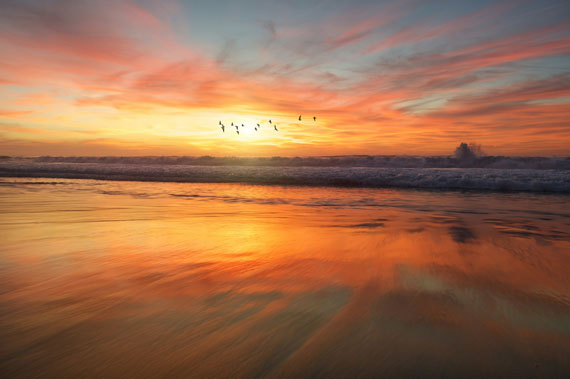The coast offers some of the most mesmerizing and dynamic landscapes a photographer can capture. From the gentle lapping of waves to the dramatic interplay of light and clouds, beachscapes present endless opportunities for creativity. Here are some essential tips to help you elevate your coastal photography and create breathtaking images.
Relevant note: PhotoMasters currently has an in-depth course on Coastal Photography

Photo captured by frank mckenna
1. Timing is Everything: Golden and Blue Hours
The best time to capture beachscapes is during the golden hour (shortly after sunrise and just before sunset) and the blue hour (just before sunrise and after sunset). During these times, the light is soft and diffused, creating a magical atmosphere with warm tones or cool blues. The long shadows and vibrant colors can add depth and drama to your images.
2. Use a Tripod for Stability
Coastal environments can be windy, and the movement of the waves can create subtle vibrations that affect the sharpness of your photos. A sturdy tripod ensures stability, especially during long exposures or when using slower shutter speeds to capture silky smooth water effects.
3. Experiment with Shutter Speeds
Long exposure photography can turn the ocean into a smooth, dreamy surface or create motion blur in the clouds. Experimenting with different shutter speeds can dramatically change the mood of your image. Use a slow shutter speed (around 1-5 seconds) to capture the fluid motion of the waves or a fast shutter speed (1/500th of a second or faster) to freeze the action and capture the details of crashing waves.
4. Incorporate Leading Lines
Beaches naturally provide several leading lines, such as the shoreline, waves, or driftwood. Use these elements to guide the viewer’s eye through the image, creating a more engaging composition. Leading lines can also add a sense of depth and dimension to your beachscapes.
5. Play with Reflections
Wet sand, tidal pools, and calm water can create beautiful reflections that add symmetry and interest to your photos. Position yourself low to the ground to capture these reflections, and use them to double the impact of a stunning sunset or dramatic cloud formation.
6. Mind the Horizon
One of the most common mistakes in coastal photography is a crooked horizon. A tilted horizon can distract from the beauty of your image and throw off the balance of your composition. Use the grid lines in your camera’s viewfinder or post-process tools to ensure the horizon is perfectly straight.
7. Capture the Details
While wide-angle shots of the entire beachscape are stunning, don’t forget to zoom in and capture the smaller details. Shells, pebbles, seaweed, and footprints can tell a story and add a personal touch to your images. Macro photography can be particularly effective in showcasing these intimate aspects of the coast.
8. Watch the Weather
Coastal weather is notoriously unpredictable, but it can also be your greatest asset. Stormy skies, fog, and dramatic clouds can add mood and atmosphere to your beachscapes. Always keep an eye on the weather forecast and be prepared to adapt to changing conditions.
9. Use Filters for Control
Neutral density (ND) filters are essential tools for coastal photography, allowing you to use longer exposures even in bright conditions. Graduated ND filters can help balance the exposure between the bright sky and the darker foreground, ensuring a well-exposed image. A polarizing filter is also useful for reducing glare and enhancing the colors of the sky and water.
10. Respect the Environment
Finally, always respect the natural environment. Avoid disturbing wildlife, and be mindful of where you walk, especially in fragile dune areas. Leave no trace of your visit, so others can enjoy the beauty of the coast as much as you do.
Conclusion
Coastal photography is all about capturing the unique and ever-changing beauty of the seaside. By paying attention to light, composition, and the environment, you can create stunning beachscapes that transport viewers to the coast. Whether you’re a seasoned photographer or just starting, these tips will help you make the most of your time by the sea.
For further training: How to Take Amazing Coastal Photos Course
- - - - - - - - - - - - - - - - - - - - - - - - - - - - - - - - - - - - - - - - - - - - - - - - - - - - - - - - - - - - - - - - - - - - - - - - - -
Photography, like any art or skill, thrives on consistency. The journey to becoming an adept photographer is paved with regular practice. Learn how PictureCorrect Insiders can help.
- - - - - - - - - - - - - - - - - - - - - - - - - - - - - - - - - - - - - - - - - - - - - - - - - - - - - - - - - - - - - - - - - - - - - - - - - -
This post Coastal Photography Tips appeared on PictureCorrect.
from PictureCorrect https://ift.tt/lGIYfEy
via IFTTT






0 kommenttia:
Lähetä kommentti